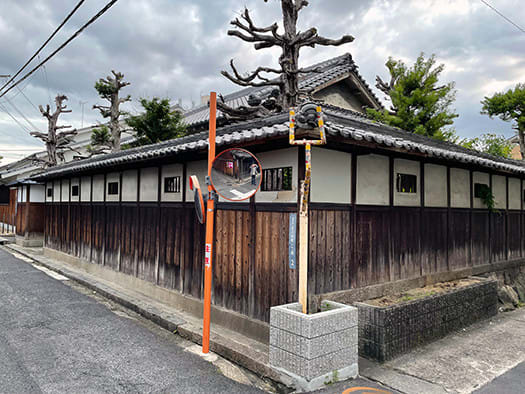

重要伝統的建造物群保存地区っていう長すぎる命名(笑)。どうもこういうのは、仕方なく指定するけれど、官僚機構としてはあんまり好ましくないとでもいった無言の抵抗も感じる。
以前、鈴木大隆さんが伝統木造派のみなさんの会合に出席して、断熱気密の重要性について孤軍奮闘で戦っている様子をはるかに後方席で、小さい声で応援していたことがありますが、参集されたみなさんはおおむね「日本の伝統建築を穢す断熱材など許しがたい」みたいな雰囲気・圧力を感じ続けていた。
その建築美への愛はよく理解できる。しかし北海道に移民した日本列島の人間は皆一様に、防寒対策の致命的欠陥に身を以てさらされ、それへの「応答」の結果として、寒冷対応技術を開発してきた。なので、マザーに於いては同じジャパンなのですよ、と言いたかった。
しかし、一方で本州地域をあちこちと「住宅建築行脚」するようになると、そういうみなさんが推奨される古建築の美感に癒されている。
きのう奈良京都のオーバーツーリズムについて書きましたが、奈良県には第2番目の人口都市・橿原がある。明治期になって初代天皇の神武天皇を祀る「橿原神宮」が創始されたが、古来、奈良盆地の交通の重要地点として栄えてきた都市。大阪方面から伊勢に行くには、横大路と言われた盆地の横断道が利用され、その最重要宿泊地域として橿原は発展してきた。現代でも人口10万人超。
奈良盆地南部地域一帯は、飛鳥の宮などのひなびた史跡群が密集している。クルマで走っていると、つぎつぎに「え、こんなとこに」っていう発見があって、いくら旅程を組んでいても足りないほど。そしてそれらがどこもさりげなく、ひっそりと佇んでいるのですね。「あら、振り向いてくれてありがとう、よかったら見ていってくださいな」。
そんなことから、徐々に橿原にホテルを探して宿泊している。わたしは「泊まれればそれでいい」みたいなコスパ重視男ですが、ふと検索したホテルが、この重要伝統的建造物群保存地区・八木町。あんまり期待も何もしていなかったけれど、駐車場無料でホテル前にある利便性。到着してから周囲を見渡したら、ごらんのような古建築が総数300軒もあるのだという。裏手には古風な神社もあって、空気感が非常に好ましい。聞いたらこの町でも著名な古建築住宅の縁戚の方が経営されている。
橿原で重要伝統的建造物群保存地区というと、堺の豪商・今井宗久の本家がある「今井町」が有名でこちらは500軒超の古建築がある。わたしの数寄なので写真もたっぷり撮影してあるけれど、こういうオーバーツーリズムに毒されていない地域、頑張って欲しいですね。
English version⬇
A familiar inn was in the “Important Preservation District for Groups of Traditional Buildings.
The traditionalists, who praise old buildings, hate thermal insulation and airtightness, but the reverse is not true. I like it even if they don't like it. ...
The name “Important Preservation Districts for Groups of Traditional Buildings” is too long (laughs). I feel that the bureaucratic structure does not really like this kind of designation, even though they have no choice but to do so, and I sense a silent resistance.
I once attended a meeting of the traditional wooden construction group, where Mr. Daitaka Suzuki was fighting a solitary battle about the importance of insulation and airtightness, and I was cheering him on in a low voice from a far back seat. I could understand their love for the beauty of architecture.
I can well understand their love for the beauty of architecture. However, all the people of the Japanese archipelago who immigrated to Hokkaido were exposed to the fatal flaw in cold protection measures, and as a result of their “response,” they have developed cold-responsive technologies. Therefore, I wanted to say that it is the same Japan in Mother.
However, on the other hand, as I have been on a “residential building tour” around the Honshu region, I have been comforted by the beauty of the ancient architecture that you have recommended.
Yesterday I wrote about over tourism in Nara-Kyoto, and in Nara Prefecture there is the second most populous city, Kashihara. Kashihara Shrine, dedicated to the first emperor of Japan, Emperor Jinmu, was founded in the Meiji period (1868-1912), and the city has prospered since ancient times as an important transportation point in the Nara Basin. To reach Ise from the Osaka area, a cross-basin road known as Yoko-oji was used, and Kashihara has developed as the most important lodging area for these travelers. Even today, the population of Kashihara exceeds 100,000.
The southern area of the Nara Basin is densely populated with Asuka's palace and other historical sites. Driving around in a car, one after another, you will discover something new, and no matter how many itineraries you have planned, you will never have enough time to see it all. And all of these places are so unobtrusive and hidden. I was always surprised at how many places I found in Kashihara, and how many places I found in my itinerary that I could not make up my mind to visit.
That is why I am gradually looking for a hotel in Kashihara and staying there. I am a cost-conscious man who is satisfied as long as I can stay at a hotel, but I suddenly searched for a hotel in Yagimachi, an important traditional building preservation district. I didn't have high expectations for the hotel, but it was conveniently located in front of the hotel with free parking. When I arrived at the hotel, I looked around and saw that there were a total of 300 old buildings, as you can see. There was also an old-fashioned shrine in the back of the hotel, which gave it a very pleasant atmosphere. I asked him about it, and he told me that it was run by a relative of a well-known old architectural family in this town.
The most famous important traditional building preservation area in Kashihara is “Imai-cho,” where the main house of Munehisa Imai, a wealthy merchant from Sakai, is located, and there are over 500 old buildings in this area. I took a lot of photos of this area because it is my neighborhood, but I hope that the area is not poisoned by over-tourism and that it will do well.










